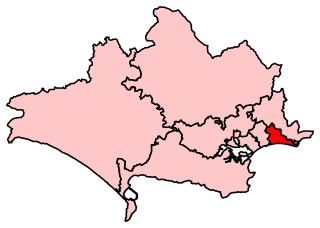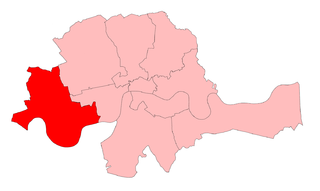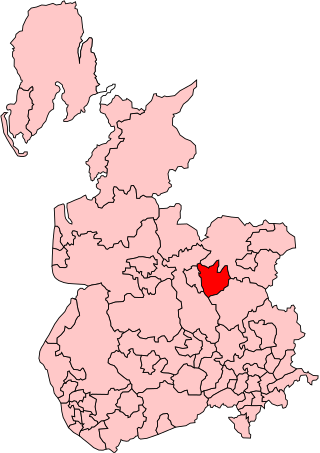Related Research Articles

Bournemouth East is a parliamentary constituency in Dorset represented in the House of Commons of the UK Parliament since 2005 by Tobias Ellwood, a Conservative.

Christchurch is a constituency in Dorset represented in the House of Commons of the UK Parliament since 1997 by Sir Christopher Chope of the Conservative Party.

Eton and Slough was a parliamentary constituency represented in the House of Commons of the Parliament of the United Kingdom. It elected one Member of Parliament (MP) by the first-past-the-post voting system.

Chelsea was a borough constituency, represented in the House of Commons of the Parliament of the United Kingdom.
Cambridgeshire is a former Parliamentary constituency in the United Kingdom. It was a constituency represented by two Members of Parliament in the House of Commons of the Parliament of England then in the Parliament of Great Britain from 1707 to 1800 and in the Parliament of the United Kingdom from 1801 to 1832, when its representation was increased to three until it was abolished in 1885.

Accrington was a parliamentary constituency of the House of Commons of the Parliament of the United Kingdom from 1885 to 1983. It elected one Member of Parliament (MP) by the first-past-the-post system of election.

Balham and Tooting was a constituency in South London, which returned one Member of Parliament (MP) to the House of Commons of the Parliament of the United Kingdom. It was created for the 1918 general election and abolished for the 1950 general election.

Hampstead was a borough constituency, centered on the Hampstead area of North London. It returned one Member of Parliament (MP) to the House of Commons of the Parliament of the United Kingdom, who was elected using the first-past-the-post voting system.
Birmingham West was a parliamentary constituency represented in the House of Commons of the Parliament of the United Kingdom. It returned one Member of Parliament (MP), elected by the first-past-the-post voting system.
Birmingham Small Heath was a parliamentary constituency centred on the Small Heath area of Birmingham. It returned one Member of Parliament (MP) to the House of Commons of the Parliament of the United Kingdom.
Wandsworth Central was a parliamentary constituency in the Wandsworth district of South London. It returned one Member of Parliament (MP) to the House of Commons of the Parliament of the United Kingdom, elected by the first-past-the-post voting system.

Kensington South was a parliamentary constituency centred on the Kensington district of west London. It returned one Member of Parliament (MP) to the House of Commons of the Parliament of the United Kingdom.
Birmingham Acock's Green was a short-lived constituency of the House of Commons of the Parliament of the United Kingdom from 1945 to 1950. It elected one Member of Parliament (MP) by the first past the post system of election.
Birmingham Moseley was a constituency of the House of Commons of the Parliament of the United Kingdom from 1918 to 1950. It elected one Member of Parliament (MP) by the first-past-the-post system of election.
Birmingham All Saints was a parliamentary constituency in the city of Birmingham, which returned one Member of Parliament (MP) to the House of Commons of the Parliament of the United Kingdom. Elections were held using the first-past-the-post voting system.
Bournemouth was a former United Kingdom Parliamentary constituency. The seat was created in 1918 and existed until it was abolished and split into two new seats in 1950. During the constituency's existence it was the most south-westerly seat in Hampshire.
East Dorset is a former United Kingdom Parliamentary constituency. It was formally known as the Eastern Division of Dorset. It was a constituency of the House of Commons of the Parliament of the United Kingdom. It was represented by one Knight of the Shire.
Bucklow was, from 1945 to 1950, a county constituency of the House of Commons of the Parliament of the United Kingdom. It elected one Member of Parliament (MP), elected by the first past the post voting system.
Bromley is a former constituency for the House of Commons of the Parliament of the United Kingdom. The most famous MP was Harold Macmillan, Prime Minister, 1957 to 1963.
Wandsworth was the name of a borough constituency created in 1885, abolished in 1918, covering the vast bulk of today's London Borough of Wandsworth in South London but excluding Battersea. It returned one Member of Parliament (MP) to the House of Commons of the UK Parliament.
References
- ↑ British parliamentary election results, 1950-1973 by FWS Craig
- Boundaries of Parliamentary Constituencies 1885-1972, compiled and edited by F.W.S. Craig (Parliamentary Reference Publications 1972)
- British Parliamentary Election Results 1950-1973, compiled and edited by F.W.S. Craig (Parliamentary Research Services 1983)
- Who's Who of British Members of Parliament, Volume IV 1945-1979, edited by M. Stenton and S. Lees (Harvester Press 1981)
- Leigh Rayment's Historical List of MPs – Constituencies beginning with "B" (part 4)